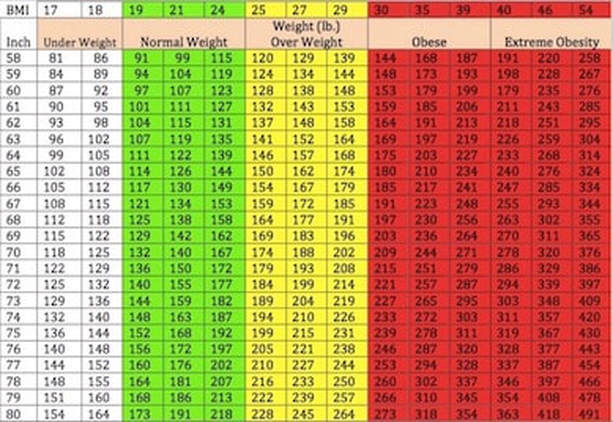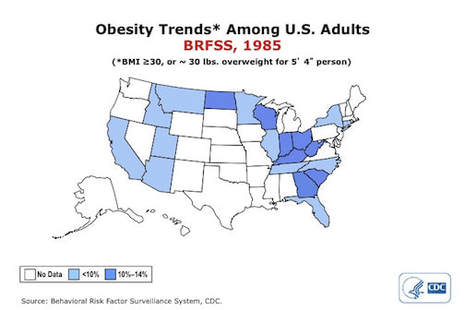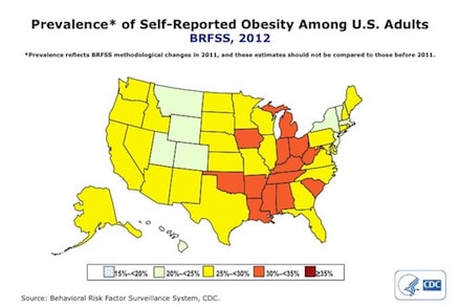Of all forms of inequality, injustice in health is the most shocking and inhuman
Dr. Martin Luther King Jr.
Dr. Martin Luther King Jr.
What's Your BMI?
- Find your height on the left column under inch.
- Go across that row until you find a weight that is nearest to your weight
- Look at the top number on the column of the weight that you selected. That top number is your BMI. Example: a person 5' tall is 60 inches tall: a. If this person weighs 125 lb. BMI = 24 b. If this person weighs 150 lb. BMI = 29 c. If this person weighs 237 lb. BMI = 46
- If you are in the green area, your disease risk is low, you are good to go!
- If you are in the yellow area, pump your brakes! Make adjustments in diet & exercise to protect your health status.
- If you are in the red area, whoa, stop! Look for an "off" ramp, you are on a road that leads to a health breakdown.
What's America's BMI?
What is BMI?
So glad you asked. BMI is the ratio of weight divided by height squared (Kg ÷ cm2)
This ratio has come to be associated with "fatness" however, that is not where it started. BMI started its life as "Quetelet Index" in 1832. Quite some time ago!
Adolphe Quetelet was a sociologist, mathematician, astronomer and statistician. He is famous for his research on human growth and development which demonstrates the "average" human physical condition. Quetelet's research demonstrated that growth of the human body is relatively stable. In fact, he found that growth and weight gain are confined to infancy and puberty stages of life. Quetelet determined that humans beings do not normally continue growing during the adult stage.
Following World War II insurance actuaries (statisticians who study human death rates in order to save their companies money) noticed that insurance companies were paying out a lot of insurance money on overweight/obese policy holders. These savvy actuaries identified the Quetelet's Index(QI) as an effective tool in assessing death risk. Those policy holders with high QI values, oddly enough, were also noted to be more likely to require premature, costly policy payouts.
In 1972 Ancel Keys renamed Quetelet's Index, the Body Mass index (BMI) in his seminal work. The most important aspect, to remember, about the BMI is not its ability to measure fatness, but instead, its established historic ability to quantify premature death risk.
Why would insurance companies be upset about covering high BMI policy holders if it were not an indicator of disease and costly premature death benefit payouts? BMI matters. Follow the money! Put your money, where the insurance companies put their's.
Invest in yourself, you will be glad you did. Give yourself the gift of living stronger, longer!
This ratio has come to be associated with "fatness" however, that is not where it started. BMI started its life as "Quetelet Index" in 1832. Quite some time ago!
Adolphe Quetelet was a sociologist, mathematician, astronomer and statistician. He is famous for his research on human growth and development which demonstrates the "average" human physical condition. Quetelet's research demonstrated that growth of the human body is relatively stable. In fact, he found that growth and weight gain are confined to infancy and puberty stages of life. Quetelet determined that humans beings do not normally continue growing during the adult stage.
Following World War II insurance actuaries (statisticians who study human death rates in order to save their companies money) noticed that insurance companies were paying out a lot of insurance money on overweight/obese policy holders. These savvy actuaries identified the Quetelet's Index(QI) as an effective tool in assessing death risk. Those policy holders with high QI values, oddly enough, were also noted to be more likely to require premature, costly policy payouts.
In 1972 Ancel Keys renamed Quetelet's Index, the Body Mass index (BMI) in his seminal work. The most important aspect, to remember, about the BMI is not its ability to measure fatness, but instead, its established historic ability to quantify premature death risk.
Why would insurance companies be upset about covering high BMI policy holders if it were not an indicator of disease and costly premature death benefit payouts? BMI matters. Follow the money! Put your money, where the insurance companies put their's.
Invest in yourself, you will be glad you did. Give yourself the gift of living stronger, longer!



